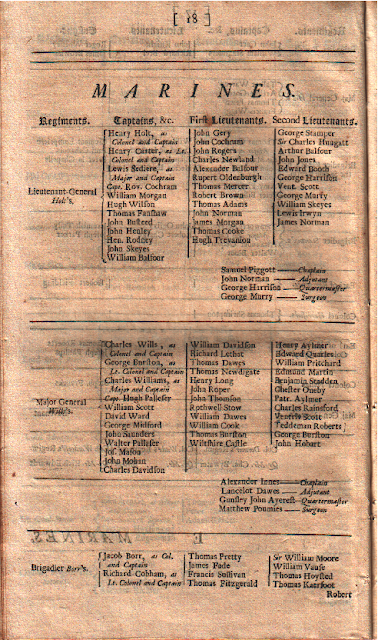Thursday 26 January 2012
Half-pay list of 1714
One of those scarce contemporary publications: A Regimental list of the half-pay officers for the year, 1714. According to the English Short Title Catalogue only less than a dozen copies are known in libraries in Britain and the United States.
This list, published by order of the House of Commons, shows all officers that were reduced, i.e. placed on half-pay, after the War of the Spanish Succession. And, as such, is a good source for tracing the careers of officers and, of course, the reduction of the army after the war in general. The list gives also an impression of officers available for the military. Not surprisingly, many of the officers are found in the regiments raised under George I after 1715.
Below an example page showing several of the regiments of marines that were disbanded in 1713.
Friday 20 January 2012
Neutrality Corps of 1710
In the first decade of the 18th Century two great wars were raging over Europe. The war over the Spanish inheritance was fought in the Spanish-Netherlands, the Rhineland, the Iberian Peninsula and several other regions. In the northern and eastern parts of Europa a conflict was fought, The Great Northern War, with Sweden, Denmark, Russia and Saxony (- Poland) being the main belligerents.
As the Great Northern War was fought in parts of the Holy Roman Empire fear existed that the war might mix with the war over the Spanish succession. The two treaties of Altranstädt of 1706 and 1707 (peace between Sweden and Saxony, and treaty between Sweden and the Emperor) took away the tension for some time. Of interest is to note that in 1707 part of the Saxon army was taken into pay of the Maritime powers.
However, in 1709 the Swedish king Karl XII was defeated by the Russians at Poltava, leading to the former's voluntary exile into Ottoman territory. This created some sort of a void in the Baltic area with Russia, Denmark and Saxony looking with much interest at Swedish territories in the region. The expected return of Karl XII and renewal of the war in the Holy Roman Empire was feared. Moreover, with the war spreading into these Swedish possessions of the Empire it was feared that Brandenburg-Prussia and Hanover might be involved as well. Which would obviously influence their part in the war against France.
On 31 March 1710 the Maritime Powers and the Emperor signed the convention of the Hague. This convention declared for the neutrality of the Swedish possessions in the Empire. In order to enforce this neutrality the signers of the convention, together with several other German powers, agreed to contribute to a corps of Neutrality. The size of the corps was set at 15,400 foot and 3,000 horse. England and the Dutch Republic would contribute six battalions each, in total 8,400 men. Other contributors were the Emperor, Prussia, Hanover, the Palatinate, Mainz, Hessen-Kassel, Münster, Mecklenburg and Wolfenbüttel.
Though the situation remained strained throughout 1710, and several contingents had already marched into Silezia, the Neutrality Corps did not have to come into action. Not because of the corps' deterrent effect, but because the events in the region, and return of the Swedish king, did not proceed as fast as expected.
(above image from Feldzüge des Prinzen Eugen von Savoyen XII. Band.)
Hostilities were resumed in 1711 anyway and the Great Northern War would continue until 1721. It also remains to be questioned how effective the corps would have been in case it should have to come into action.
As the Great Northern War was fought in parts of the Holy Roman Empire fear existed that the war might mix with the war over the Spanish succession. The two treaties of Altranstädt of 1706 and 1707 (peace between Sweden and Saxony, and treaty between Sweden and the Emperor) took away the tension for some time. Of interest is to note that in 1707 part of the Saxon army was taken into pay of the Maritime powers.
However, in 1709 the Swedish king Karl XII was defeated by the Russians at Poltava, leading to the former's voluntary exile into Ottoman territory. This created some sort of a void in the Baltic area with Russia, Denmark and Saxony looking with much interest at Swedish territories in the region. The expected return of Karl XII and renewal of the war in the Holy Roman Empire was feared. Moreover, with the war spreading into these Swedish possessions of the Empire it was feared that Brandenburg-Prussia and Hanover might be involved as well. Which would obviously influence their part in the war against France.
On 31 March 1710 the Maritime Powers and the Emperor signed the convention of the Hague. This convention declared for the neutrality of the Swedish possessions in the Empire. In order to enforce this neutrality the signers of the convention, together with several other German powers, agreed to contribute to a corps of Neutrality. The size of the corps was set at 15,400 foot and 3,000 horse. England and the Dutch Republic would contribute six battalions each, in total 8,400 men. Other contributors were the Emperor, Prussia, Hanover, the Palatinate, Mainz, Hessen-Kassel, Münster, Mecklenburg and Wolfenbüttel.
Though the situation remained strained throughout 1710, and several contingents had already marched into Silezia, the Neutrality Corps did not have to come into action. Not because of the corps' deterrent effect, but because the events in the region, and return of the Swedish king, did not proceed as fast as expected.
(above image from Feldzüge des Prinzen Eugen von Savoyen XII. Band.)
Hostilities were resumed in 1711 anyway and the Great Northern War would continue until 1721. It also remains to be questioned how effective the corps would have been in case it should have to come into action.
Labels:
diplomacy,
Great Northern War,
Spanish Succession
Monday 9 January 2012
Portuguese regiments in British pay
English, Scots and Irish regiments of the British Army can provide for a great deal of research pleasure for the student of British military history and the lineage addict aficionado. Foreign regiments in British service provide an additional challenge when it comes to finding proper details of the regiments in question. When found, details are often sketchy, incomplete and they may even be contradicting. Adding to the confusion is the broad range of regiments that can be called foreign.
As could be read on this blog before a large number of German troops were in English pay during the Nine Years' War and the War of the Spanish Succession. Such troops entered English pay and service through contracts signed between England and the German state in question. Terms of service and pay were laid down in the contract. Huguenot regiments are also found in English service, and they can be considered foreign as well. Their origin, and reasons for existence differed from that of, for example, the German regiments. In 1708-09 we find a number of Portuguese regiments entering English pay, with yet another background. (The need for more men and bayonets is in most cases probably the ultimate reason why a regiment came into being anyway.)
By late 1708, as various English regiments had been disbanded, reduced or merged in 1707 and 1708, five new regiments were to be formed in Portugal as replacements: one regiment of dragoons and one of foot. These regiments were to be formed from Portuguese [soldiers], but officered by English and, mostly, French Huguenots. The British treasury paid for the regiments. Commissions were given without date, to be filled in Portugal, and did not exceed the rank of lieutenant-colonel. Though information was not found, the colonelcies were most likely bestowed on Portuguese. Because the regiments were Portuguese, the king of Portugal objected against the idea of having French Protestants commanding his regiments. This delayed the completion of the regiments, which did not happen before summer 1709. By the time the regiments were fully embodied, it was also decided to reorganize the four regiments of foot into five additional regiments of dragoons.
The History of the Reign of Queen Anne for 1709 gives a list of colonels, lieutenant-colonels and majors:
Since the regiments appear in precedence lists compiled after the war it seems likely that the regiments were considered native some time afterwards. In 1712 the following colonels are listed (in order of precedence of their regiment):
All six regiments of dragoons mentioned above were disbanded by 1712 and its officers were placed on half-pay. This seems also an indication that at some point the regiments were no longer foreign.
As could be read on this blog before a large number of German troops were in English pay during the Nine Years' War and the War of the Spanish Succession. Such troops entered English pay and service through contracts signed between England and the German state in question. Terms of service and pay were laid down in the contract. Huguenot regiments are also found in English service, and they can be considered foreign as well. Their origin, and reasons for existence differed from that of, for example, the German regiments. In 1708-09 we find a number of Portuguese regiments entering English pay, with yet another background. (The need for more men and bayonets is in most cases probably the ultimate reason why a regiment came into being anyway.)
By late 1708, as various English regiments had been disbanded, reduced or merged in 1707 and 1708, five new regiments were to be formed in Portugal as replacements: one regiment of dragoons and one of foot. These regiments were to be formed from Portuguese [soldiers], but officered by English and, mostly, French Huguenots. The British treasury paid for the regiments. Commissions were given without date, to be filled in Portugal, and did not exceed the rank of lieutenant-colonel. Though information was not found, the colonelcies were most likely bestowed on Portuguese. Because the regiments were Portuguese, the king of Portugal objected against the idea of having French Protestants commanding his regiments. This delayed the completion of the regiments, which did not happen before summer 1709. By the time the regiments were fully embodied, it was also decided to reorganize the four regiments of foot into five additional regiments of dragoons.
The History of the Reign of Queen Anne for 1709 gives a list of colonels, lieutenant-colonels and majors:
- Balthasar de Foissac
- Hunt Withers
- Jean Desbordes
- Constantine de Magny
- Paul de Gually
- Joseph de Sarlande
All six regiments of dragoons mentioned above were disbanded by 1712 and its officers were placed on half-pay. This seems also an indication that at some point the regiments were no longer foreign.
Subscribe to:
Posts (Atom)







